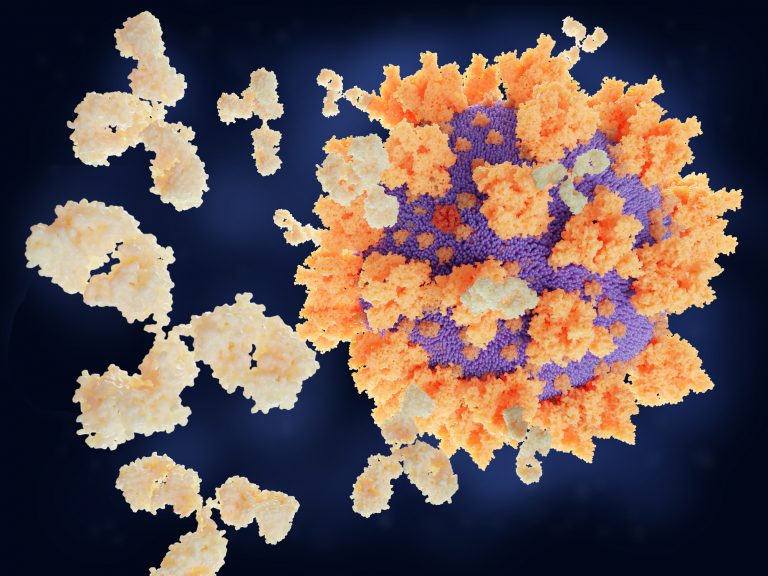
A Phase II/III trial of a new, fully-human polyclonal antibody therapeutic targeted to SARS-CoV-2 has begun enrolling non-hospitalized people with mild or moderate cases of COVID-19.
SAB Biotherapeutics’ SAB-185 was developed using genetically-engineered cattle that generate a human response to the virus. The resulting antibodies are then harvested. It is similar to convalescent plasma, but from cows.
SAB reports on their website that “Tc Bovine–our genetically-engineered cattle–mount the same immune response as survivors of a disease, such as COVID-19, with a much higher concentration of targeted neutralizing antibodies.”
New treatments for COVID-19 are urgently needed. While several drugs are in use for the disease, including antivirals, steroids, and monoclonal antibody (MAB) combinations, the condition is often still life threatening and debilitating for patients with serious disease or at high risk for it. While convalescent plasma treatment was a popular idea early in the pandemic, results have been controversial and based on limited evidence so far.
The SAB-185 trial is part of ACTIV-2, which is sponsored by the National Institute of Allergy and Infectious Diseases (NIAID), part of the National Institutes of Health. ACTIV-2 is a master protocol designed to evaluate multiple investigational agents in adults with mild-to-moderate COVID-19 who are not hospitalized. Led by the NIAID-funded AIDS Clinical Trials Group (ACTG) and supported by the CRO PPD, which executes the trials, it will enroll participants at sites around the world.
ACTIV-2 was initiated in August 2020 and has since then started testing several treatments. This trial will evaluate SAB-185 in a small group of volunteers and then continue testing it in a larger group if the treatment appears safe and effective.
The drug has already completed enrollment of Phase I and Phase Ib clinical studies. In previous pre-clinical studies, it demonstrated neutralization of live SARS-CoV-2 at titers higher than convalescent plasma.
SAB-185 is administered intravenously, with the dose depending on the patient’s weight in kilograms (kg). A high and a low dose of SAB-185 will be tested in this trial. When participants enroll in ACTIV-2, they will be assigned at random to receive either SAB-185, another therapeutic currently being evaluated in ACTIV-2, or a placebo.
Other therapeutics currently being evaluated in ACTIV-2 include:
- A regimen of two experimental antibodies, BRII-196 and BRII-198, developed by Brii Biosciences based in Durham, North Carolina and Beijing, China.
- SNG001, an inhalable beta interferon developed by Synairgen based in Southampton, United Kingdom.
- AZD7442, a long-acting monoclonal antibody combination administered by either an intravenous infusion or an intramuscular injection, developed by AstraZeneca based in Cambridge, United Kingdom.
- Camostat mesilate, an orally administered serine protease inhibitor developed by Sagent Pharmaceuticals based in Schaumburg, Illinois.
The evidence to date suggests that early in the clinical course, COVID-19 is primarily driven by viral replication, but later it is driven by a dysregulated immune/inflammatory response to the virus, which leads to tissue damage. As a result, it’s believed that antiviral therapies should have the greatest effect early in the course of the disease, while immunosuppressive/anti-inflammatory therapies are likely to be more beneficial in the later stages. Antibody therapeutics have so far been recommended for early stage disease, as they impede viral replication.
In October 2020, the antiviral Veklury (remdesivir) became the first drug approved for treatment of COVID-19. It had been available under Emergency Use Authorization (EUA) since May. Several other drugs have also been granted EUA, including the rheumatoid arthritis drug Olumiant (baricitinib), which reduces inflammation and has antiviral activity, and the MAB cocktails REGEN-COV (casirivimab and imdevimab) from Regeneron and Eli-Lilly’s Bamlanivimab and etesevimab.
The MABs are specifically targeted to the spike protein of SARS-CoV-2 and designed to block the virus’ attachment and entry into human cells. Each MAB binds to different but overlapping sites on the spike protein of the virus.













